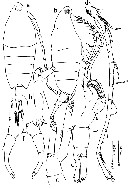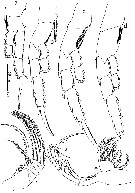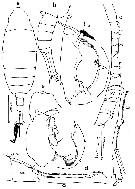|
|
 |
|
Calanoida ( Order ) |
|
|
|
Diaptomoidea ( Superfamily ) |
|
|
|
Tortanidae ( Family ) |
|
|
|
Tortanus ( Genus ) |
|
|
|
Atortus ( Sub-Genus ) |
|
|
| |
Tortanus (Atortus) sulawesiensis Mulyadi, Nishida & Ohtsuka, 2017 (F,M) | |
| | | | | | | Ref.: | | | Mulyadi, Nishida & Ohtsuka, 2017 (p. 79, Descr. F, M, figs. F,M, Rem.) |  Issued from: Mulyadi, S. Nishida & S. Ohtsuka in Crustaceana, 2017, 90 (1). [p.80, Fig.1]. Female (from 1°23.491'N, 125°06.460'E): a-b, habitus (dorsal and lateral, respectively); c, urosome (dorsal); d, A1; e, Mxp; f, P5; g, A2; h, Md palp and gnathobase. Nota: - Prosome about 3.2 times as long as urosome. -Posterior corners of prosome produced into symmetrical, rounded lobes, reaching anterior 1/3 of genital compound somite. - Urosome 2-segmented. Genital compound somite symmetrical, about twice as long as anal somite, with large ventral process, parallelogramic in lateral view. - Anal somite asymmetrical, right margin more convex and longer than left. - Caudal rami asymmetrical, right ramus slightly wider and shorter than left, anterior part of left ramus curved medially. - A1 symmetrical, 15-segmented (ancestral segments I-IX, XI-XIV, XXVI-XXVIII fused), reaching mid-length of urosome. - A2: coxa naked; basis completely fused with proximal segment of endopod; exopod shorter than endopod and 2-segmented, 1st segment extremely short with no seta, 2nd segment about 6 times as long as 1st segment and furnished with short mediodistal seta and 4 apical setae; endopod 3-segmented, proximal segment furnished with tuft of setules; 2nd segment incompleterly fused with distal segment; distal segment bearing 6 distal setae. - Md: palp with elongate basis (more than twice as long as endopod and exopod); exopod and endopod 2-segmented, distal segment with 5 and 6 apical setae, respectively; gnathobase bearing 5 cuspidate teeth and 4 rows of spinules. - Mxp: syncoxa with 2 endites, each with spinulose seta; basis unarmed; endopod with 3 medial spinulose setae and lateral seta. - P5 symmetrical, 3-segmented including common coxa; basis with seta near middle of lateral margin; exopod slightly curved medially, ending in 3 semiparallel prongs (central prong longest).
|
 Issued from: Mulyadi, S. Nishida & S. Ohtsuka in Crustaceana, 2017, 90 (1). [p.82, Fig.2]. Female : a-d, P1 to P4; e, Mx1; f, Mx2. Nota: - Mx1: praecoxal arthrite (1st inner lobe 1 with 13 stout setae; distal segment elongated with 3 strong, pectinate terminal setae, tips of which serrated, medial margin with row of spinules. - Mx2: syncoxal endites with 1, 2, 2 and 3 setae from proximal to distal; basal endite with 1 developed and 2 rudime,tary setae; endopod with 5 stout setae with claw-like tip and 2 rudimentary setae.
|
 Issued from: Mulyadi, S. Nishida & S. Ohtsuka in Crustaceana, 2017, 90 (1). [p.81]. Female & Male: Armature formula of swimming legs P1-P4. Spine indicated by Roman numerals, seta by Arabic numerals.
|
 Issued from: Mulyadi, S. Nishida & S. Ohtsuka in Crustaceana, 2017, 90 (1). [p.83, Fig.3]. Male : a, habitus (dorsal); b, posterior part of pediger 5 and urosome (right lateral view); c, d, right A1 (number of ancestral segment indicated by Roman numerals); e, right P5; f, left P5. Nota: - Prosome about 2.8 times as long as urosome; - Posterior corners of prosome not extending posteriorly as in female. - Urosome symmetrical with 5 somites, devoid of any lateral protrusions. - Caudal rami symmetrical, 5.3 times as long as wide. - Appendages similar to those of female, except right A1 and P5. - Right A1 geniculate, with segments XVI-XIX swollen; segment XX equal in length to fused segments XXIV-XXVIII and slightly longer than fused segments XXI-XXIII; anterior surface of segment XX furnished with ridge bearing denticles; ride extending just short of distal end of segment; distal end of ridge slightly raised from surface plane of segment; fused segments XXI-XXIII also furnished with ridges devoid of denticles on anterior surfaces; hinge joint formed between segment XX and fused segments XXI-XXIII; later segment with indent on anterior surface near proximal end; distal end of segment with a long spinous process extending almost entire length of fused segments XXIV-XXVIII. - P5: Right leg coxa swollen without any processes; basis swollen, curved medially and bearing large acutely pointed process arising near inner proximal end; medial margin of segment with 3 lamellae, proximal one with 3 rounded processes, middle one triangular, and distal one digitiform with rounded tip and subterminal setule; exopod claw-like with main curvature at proximal 1/3, furnished with setule on medioproximal margin, and subdistal spinule on lateral marginj, medial margin with subdistal tongue-like process running toward and short of distal end, segment ending in two pointed tips, lateral tip longer and more acute than medial one. Left leg: coxa devoid of any process; basis medial margin swollen near proximal and distal ends, furnished with one seta each near distal 1/3 of lateral and medial margins; exopodal segment 1 with digitiform process with terminal seta near proximal 1/3 of medial margin and subdistal seta; exopodal segment 2 bearing rounded process on proximomedial margin with seta at its base, lateral margin hirsute on distal 1/5, medial margin bearing series of lamellae running from midlength to distal end of segment and subterminal spine, apex with long sinuate spine.
| | | | | NZ: | 1 | | |
|
Distribution map of Tortanus (Atortus) sulawesiensis by geographical zones
|
| | | | Loc: | | | Indonesia (off Tanjung Merah, Sulawesi Is). | | | | N: | 1 | | | | Lg.: | | | (1314) F: 2,28-2,39; M: 1,96-2,22; {F: 2,28-2,39; M: 1,96-2,22} | | | | Rem.: | For Mulyadi and al. (2017, p.84), Tortanus (A.) sulawesiensis is assigned to the murrayi species group of the recticauda species complex and closely resembles T. (A.) murrayi Scott, 1909, T. (A.) scaphus Bowman , 1971, T. (A.) lophus Bowman, 1971, and T. (A.) bonjol Othman, 1987, by the absence of characteristic processes on Pediger 5 and the genital compound somite of the female, and the basic structure of P5 in both sexes, but is distinguished from the latter four species by the ventral process on the genital compound somite and the shape of caudal rami in the female, and the characteristic shapeof the tongue-like process on the exopod of the right P5 and of the lammellae of exopodal segment 2 of the left P5 in the male. | | | Last update : 03/04/2018 | |
|
|
 Any use of this site for a publication will be mentioned with the following reference : Any use of this site for a publication will be mentioned with the following reference :
Razouls C., Desreumaux N., Kouwenberg J. and de Bovée F., 2005-2025. - Biodiversity of Marine Planktonic Copepods (morphology, geographical distribution and biological data). Sorbonne University, CNRS. Available at http://copepodes.obs-banyuls.fr/en [Accessed October 21, 2025] © copyright 2005-2025 Sorbonne University, CNRS
|
|
 |
 |






